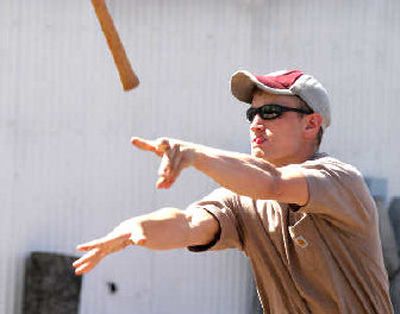Skills and stamina

Logging is still in its heyday at the University of Idaho, where the logging sports team members compete in tests of skill and stamina with ax and chain saw.
“We are about tradition,” said Rodney Cochrane, captain of UI’s 27-member team. “Every event we do has ties to logging of the heyday or the present.”
It requires speed, agility, savage power, stamina, coordination and guts to excel. Imagine racing to the top of a 50-foot pole wearing spike pegs on your feet a leather belt that is wrapped around the pole as your means to climb.
“Even today,” Cochrane said, “we still have people in the woods climbing massive trees to take huge wood out in sections. All these events emulate logging.”
Like the saw-bucking contest, featuring a tool once used by every logger before power saws where invented. Here you can compete by yourself or as part of a two-man, two-woman or combination “Jack and Jill” team. The outcome is the same – all contestants use razor-sharp saws and sheer power and technique to rip through a 22-inch diameter log at the speed of a modern-day chain saw.
The underhand chop, another favorite event, features a 6-pound ax. The goal is to chop a log in half faster than your competitiors.
Jennifer Benedict, a second-year forestry student at the University of Montana, is a little tired after doing the underhand chop.
“I’m not used to this ax. It’s a little longer and heavier than the one I normally compete with,” she said.
Students are allowed to compete in up to eight events out of 12, including skill events like sawing or chopping and “hobby” events like ax-throwing or the caber toss, in which a long, heavy pole is thrown end over end.
“Logging sports have been around for a long time,” said Annie Beall, who has competed for more than 20 years and coaches the Flathead Valley Community College team in Kalispell, Mont. The last of four Northwest college competitions held this year was UI’s Lumberjack Classic, held in Moscow the last Saturday in April.
Brenda Pouchnik, a logging sports competitor and UI team coach along with her husband, Derek, started competing at the age 8 in Canada. Her dad, a logger and competitor, got her started.
Women’s event have come a long way since Beall first started swinging an ax.
“It use to be one, maybe two, events for the woman, the Jack and Jill crosscut and maybe an ax-throw,” she said. Today, women compete in all events.
“You win with your women’s team,” said Beall. “Teams who do better traditionally are the ones with the stronger woman team.”
Beall especially likes log-rolling or birling. She still competes while raising an 11-month-old Emily, “who I’m hoping to train in log-rolling someday.”
Jessica Hendricks, a sophomore in physical therapy at the University of Washington, likes the camaraderie the events inspire.
“I love it. I’ve been doing it for two years, and met my husband here,” she said. “It’s a wonderful sport with great companionship. It’s like one big family.”
Each school with a forestry program hosts a competiton and each region has one big event – the conclave. This year the American Western Forestry Clubs’ Conclave was hosted by Cal-Poly San Luis Obispo, Calif.
“The Great Outdoor Games,” seen on ESPN, has been showing the Pro Logging Competition for the last five years, and four years ago, began airing college conclave competitions.
“Next year, the conclave will be held right here, at the University of Idaho,” said Cochrane. Although there is no log-rolling competition area at Moscow, Cochrane hopes to raise enough money to have one built by next year.
“The birling or log rolling right now is being pushed for an Olympic event,” adds Pouchnik.